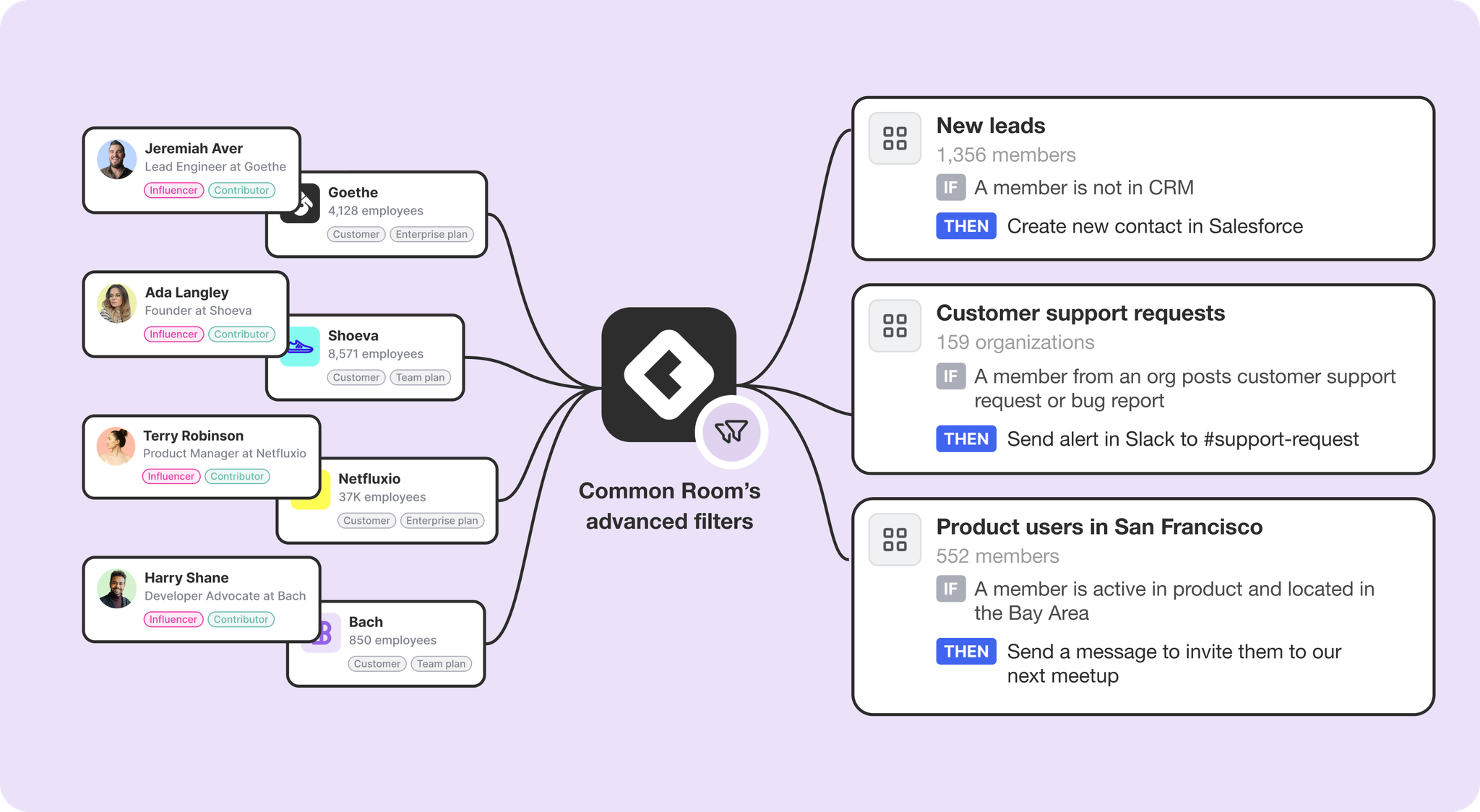Commercial open-source software (COSS) companies have a paradox problem.
Open-source software is a powerful customer acquisition channel that delivers high-fit sales opportunities right to your doorstep. Yet the very nature of open-source software makes it difficult to spot sales opportunities and take action on them.
In other words, your greatest strength is your biggest weakness.
Now the good news: It doesn’t have to be.
Keep reading to learn:
- Why open-source strategy creates blind spots
- What’s required to fuel your open-source growth engine
- How leading COSS companies power go-to-market
You don’t know what you don’t know
Commercial open-source software is the pinnacle of product-led growth (PLG). Some companies give you a free trial—COSS companies give you the source code.
People help themselves to an open version of your software, tinker with it to see if it can solve their problem, then (hopefully) raise their hands when they’re ready to talk enterprise.
Cue your go-to-market team swooping in to sell high-fit users on your premium offering (you know, the one with the extra features and functionalities, dedicated support, and cloud hosting options?).
It’s all very straightforward—in theory. But COSS companies have it harder than your average PLG venture.
PLG companies struggle to piece together their view of the customer using disjointed product data, but COSS companies don’t even have that to work with.
Some organizations gate downloads of their open-source software to collect user data, but that defeats the purpose. The whole point is that developers are more likely to use your software when there’s no barrier to entry (and no risk of unwanted sales outreach).
Even if you do enforce some type of log-in process across your owned channels, you can’t control how people access your software from third-party repositories.
The result is zero visibility into who’s using your code, and how, beyond what users tell you directly. That means the user data your marketing and sales teams need to find and nurture leads is lost.
When software is openly distributed, it works as a top-of-funnel growth mechanism. But there’s a big difference between forever hobbyists and viable business opportunities.
To run an open-source playbook that actually generates revenue, you have to push the right people down the funnel.
The building blocks of open-source selling
COSS companies use a number of homegrown workarounds to get user visibility. The problem is they’re tedious, time-consuming, and ineffective.
Say you decide to manually sift through GitHub to scare up prospects. You could spend hours sussing out a person’s name and company, doing LinkedIn searches to fill in the rest of the gaps, then adding your findings to a spreadsheet.
But you’d have to repeat that process for each and every repo star and pull request.
To translate open-source activity into sales opportunities, COSS companies need a scalable, GTM-friendly way to uncover:
User identity
You need to know exactly who’s engaging with your software.
Anonymous downloads won’t tell you if someone fits your ideal customer profile (ICP). To separate the needle from the haystack, you have to be able to filter opportunities for fit, whether it’s based on job description, organization, industry, annual revenue, technology stack, or some other dimension.
Team-wide insights
You need to know if you’re looking at a lone wolf or a team spec’ing out a project.
Not all intent signals are equal. If someone stars your repo, you probably want to know about it. But if multiple users from a qualified account do it? That’s something you want to know about yesterday.
Cross-channel activity
You need to know where people are engaging with your software, why, and how they feel about it.
Intent and fit are key, but context is king. When it comes to converting free users into paying customers, it’s essential to know where to reach out to them and when. Meeting customers where they are—in the right place and at the right time—counts for a lot more than a generic email.
How to capitalize on your COSS ecosystem with Common Room
Common Room is built to help you identify the real people behind hard-to-see user activity and take action with confidence.
Our AI-powered identity resolution and enrichment provide you with key demographic and firmographic information across all your connected data sources, from Discord to GitHub and everything in between. You’ll get a bird’s eye view of all individuals who interact with your organization, where they work, and how to reach them.
🎤 “Common Room is kind of that foundational platform where we funnel all information about things that are happening. We have our Slack group, we have our Community Forum, we have social media, we have things like Reddit and Stack Overflow and all of those things, and we integrate all of that into the Common Room platform.”
—Anna Filippova, Senior Director of Community and Data at dbt Labs

You can easily filter individuals and organizations based on the attributes and actions that matter most to you—such as role, location, programming language, organization size, and more—so you not only know exactly who’s engaging with you, but also whether they’re worth pursuing.
🎤 “Common Room helps us focus on the organizations that get the most value from our product. We know which attributes make someone a great fit for Replit. Before Common Room, I wasn't able to find and build relationships with these people."
—Lena Vu Sawyer, Head of Community at Replit

Automatically tag users and the companies they work for to quickly zero in on economic buyers and companies that fit your ICP. These individuals and organizations can then be added to segments so you can track their status, stay updated on their activity, and engage them when it makes sense.
🎤 “Common Room gives me a daily feed of all the prospects I want to engage from multiple channels all in one place. It saves me so much time and energy as far as prospecting and organizing my day.”
—Gozie Nwachukwu, Head of Sales Development at Temporal

With a centralized view of all relevant activity across channels, it’s easy to keep up with the conversations and actions hidden in your dark funnel, from product questions to sentiment. Real-time alerts make it easy to know when opportunities go from interesting to actionable, and automated workflows help you organize leads and reach out to them on the channels they prefer at scale.
🎤 "I'm very data-driven, and when it comes to community intelligence and workflows, I've never seen anyone do it as comprehensively or as elegantly as Common Room. Nothing else in the market is close."
—Jared Jones, Head of Ecosystem at Moov

Open-source should be your superpower, not your kryptonite.
Common Room helps you connect the dots between user activities, spotlight the best opportunities, and act on them fast.
Supercharge your open-source sales strategy with Common Room
Ready to see how Common Room helps you power commercial open-source software success?

